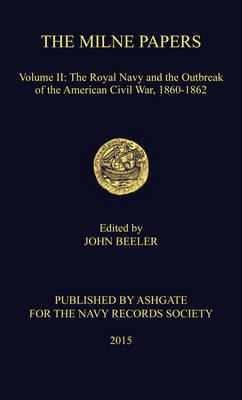Navy Records Society Publications
3 total works
Centred upon a man who never participated in combat operations during his sixty-year naval career, this volume depicts the routine peacetime operations of the mid-Victorian Royal Navy, operations that have received short shrift in naval histories, even though they have constituted the bulk of the service's mission during the past two centuries.
Not surprisingly, the Navy operated in support of the liberal state and its agenda, as many of the documents in this collection make clear. Following the Monroe Doctrine in 1823, both Britain and the United States moved quickly to exploit new trade opportunities and for the next seventy years it was the Royal Navy that enforced the Doctrine, to the benefit of British commercial interests, but also to those of the United States and of any other country engaged in legitimate trade in the hemisphere. The service took the lead in combating piracy and the slave trade, and upheld the rule of law across global trade routes. The documents that comprise this volume therefore deal with topics of interest to scholars of international relations, Anglo-American affairs, the U.S. Civil War and the slave trade. Other aspects addressed include naval medicine, steam-era logistics and other elements of the Royal Navy's modernization pertaining to its materiel, personnel, and administration.
The Mediterranean Fleet entered the 1930s looking back to the lessons of Jutland and the First World War but also seeking to incorporate new technologies, notably air power. Unfortunately in the depression years of the early 1930s there was a lack of funds to remedy deficiencies. The problem became critical during the Abyssinian crisis of 1935.
The crisis wound down by mid-1936 but the respite did not last long. In June 1936 the Spanish Civil War broke out and the Mediterranean Fleet was soon involved in evacuations of British and other endangered foreigners from Spanish ports as well as the protection of British flagged merchant ships in the war zone.
In addition to the Spanish Civil War there was an increase of tension with Germany in 1938 that culminated with the Czechoslovak crisis in September. The situation of the Mediterranean Fleet and its possible actions had the Munich agreement not been reached are described. The Spanish Civil War ended in 1939 with the victory of the Nationalists and the Mediterranean Fleet was again involved in evacuations. By now the prospect of war with Germany and possibly Italy was quite clear and serious preparations for war continued. The plans for war in the Mediterranean are reproduced in detail.
This is the first of three volumes detailing the history of the Fleet Air Arm, the Royal Navy's aircraft carriers and naval air squadrons, during the Second World War. It deals with the formative period between 1939 and 1941 when the Fleet Air Arm tried to recover from the impact of dual control and economic stringencies during the inter-war period while conducting a wide range of operations. There is in depth coverage of significant operations including the Norwegian campaign, Mediterrranean actions such as the attack on the Italian Fleet at Taranto and the Battle of Cape Matapan, and the torpedo attacks on the German battleship Bismarck. Incidents involving the loss of and damage to aircraft carriers, including the sinking of Ark Royal, one of the most famous ships in the early years of World War Two, are also reported. Of major importance are key planning and policy issues. These include the requirements for aircraft carriers, the evolving debate regarding the necessary types of aircraft and attempts to provide sufficient facilities ashore for naval air squadrons. A wide range of official documents are used to enable the reader to appreciate the complexity of the operations and other issues which faced the Fleet Air Arm.
This volume will appeal to everyone interested in how the Royal Navy adapted to the use of air power in the Second World War. Its reports bring actions vividly to life. Its correspondence demonstrates the fundamental foundation of planning, policy and logistics. In common with succeeding volumes on the Fleet Air Arm, this volume provides a new and vital perspective on how Britain fought the Second World War.


